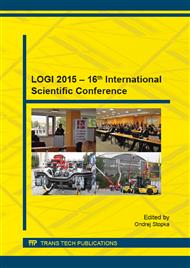[1]
A. Arulesvaran, Changing with Lean Six Sigma, Clarion Reviews, (2010).
Google Scholar
[2]
M. Bauer, K. Vicek, et al., Kaizen Way to lean and flexible enterprise, BizBooks, Czech Republic, (2012).
Google Scholar
[3]
I. Bass, Six Sigma Statistics with Excel and Minitab, McGraw Hill Professional, (2011).
Google Scholar
[4]
B. Bertsche, Reliability in automotive and mechanical engineering: determination of component and system reliability, Springer Science & Business Media, (2008).
Google Scholar
[5]
F. W. Breyfogle, Implementing Six Sigma: Smarter Solutions Using Statistical Methods, John Wiley & Sons, (2003).
DOI: 10.1002/qre.369
Google Scholar
[6]
R. Burlton, Business Process Management: Profiting From Process, Pearson Education, (2001).
Google Scholar
[7]
E. Cempirkova, Diploma thesis, University of Pardubice, Pardubice, Czech Republic, (2006).
Google Scholar
[8]
A. Chauhan, R.K. Malik, G. Sharma, M. Verma, Performance evaluation of casting industry by FMEA - A case study, In: International Journal of Mechanical Engineering Applications Research, Vol. 2 (2011).
Google Scholar
[9]
C. Dougherty, Introduction to Econometrics, Oxford University Press, Oxford, (2011).
Google Scholar
[10]
H. Drahotska, I. Drahotsky, Crime in the Logistics, In: LOGI 2010: conference proceeding. Tribun EU, Brno, Czech Republic, (2010).
Google Scholar
[11]
M. Dudek-Burlikowska, Application of FMEA method in enterprise focused on quality, In: Journal of Achievements in Materials and Manufacturing Engineering, Vol. 1 (2011) 89-102.
Google Scholar
[12]
J. Gasparik, J. Siroky, L. Peceny, M. Halas, Methodology for assessing the quality of rail connections on the network, In: Communications: scientific letters of the University of Zilina, Vol. 2 (2014) 25-30.
DOI: 10.26552/com.c.2014.2.25-30
Google Scholar
[13]
L. Hamblenton, Treasure Chest of Six Sigma Growth Methods, Tools, and Best Practices. Pearson Education, (2007).
Google Scholar
[14]
R. Hruska, P. Prusa, D. Babic, The use of AHP method for selection of supplier, In: Transport, Vol. 2 (2014) 195-203.
Google Scholar
[15]
J. Jaros, V. Melichar, L. Svadlenka, Optimal capital structure as a tool of company competitiveness, In: International multidisciplinary scientific conferences on social sciences & arts, SGEM 2014, Bulgaria, Conference proceedings, Vol. 2 (2014).
DOI: 10.5593/sgemsocial2014/b22/s6.067
Google Scholar
[16]
H.J. Johansson, Business Process Reengineering: Breakpoint Strategies for Market, Dominance Wiley, (1993).
Google Scholar
[17]
R.M. Khan, Problem Solving and Data Analysis Using Minitab: A Clear and Easy Guide to Six-Sigma Methodology, John Wiley & Sons, (2013).
DOI: 10.1002/9781118307502
Google Scholar
[18]
J. Kosturiak, J. Chai, Innovation, your competitive advantage, Computer Press (CPress), Czech Republic, (2008).
Google Scholar
[19]
I. Kubasakova, R. Kampf, O. Stopka, Logistics information and communication technology, In: Communications, Vol. 2 (2014) 9-13.
Google Scholar
[20]
S. Lesik, Applied Statistical Inference with MINITAB, Taylor & Francis, (2009).
Google Scholar
[21]
S.L. Lipol, J. Haq, Risk analysis method: FMEA/FMECA in the organizations, In: International Journal of Basic & Applied Sciences IJBAS-IJENS, 2011, pp.74-81.
Google Scholar
[22]
P.G. Mathews, Design of Experiments with MINITAB, ASQ Quality Press, (2005).
Google Scholar
[23]
D.S. Moore, The Basic Practice of Statistics, Palgrave Macmillan, (2010).
Google Scholar
[24]
S. Narayanagounder, K. Gurusami, A New Approach for Prioritization of Failure Modes in Design FMEA using ANOVA, World Academy of Science, In: Engineering and Technology, Vol. 3 (2009) 1-14.
Google Scholar
[25]
A. Rosova, Logistics costs of the enterprise, In: Acta Montanistica Slovaca, Vol. 2 (2007) 121-127.
Google Scholar
[26]
N. Sellappan, K. Palanikumar, Modified prioritization methodology for risk priority number in failure mode and effects analysis, In: International Journal of Applied Science and Technology, Vol. 4 (2003).
Google Scholar
[27]
N. Sellappan, K. Palanikumar, Development of modified evaluation and prioritization of risk priority number in FMEA, In: International Journal of Engineering (IJE), Vol. 1 (2013).
Google Scholar
[28]
A. Sleeper, Six Sigma Distribution Modeling, McGraw Hill Professional, (2006).
Google Scholar
[29]
H.W. Stoll, Product Design Methods and Practices, CRC Press, (1999).
Google Scholar
[30]
K. Subburaman, A Modified FMEA Approach to enhance reliability of lean systems, Master's Thesis, University of Tennessee, (2010).
Google Scholar
[31]
A. Svozilova, Business process improvement, Grada Publishing a. s., Czech Republic, (2011).
Google Scholar
[32]
M. Solc, Applying of Method FMEA (Failure Mode and Effects Analysis) in the Logistics Process, Department of Integrated Management, Technical University of Kosice, Faculty of Metallurgy, Slovak Republic, Advanced Research in Scientific Areas, (2012).
Google Scholar
[33]
J. Vachal, M. Vochozka, Business Management, Grada Publishing a. s., Czech Republic, (2013).
Google Scholar
[34]
M. Weske, Business Process Management: Concepts, Languages, Architectures, Springer Science & Business Media, (2012).
Google Scholar
[35]
M. Andrejiova, A. Grincova, D. Marasova, G. Fedorko, V. Molnar, Using logistic regression in tracing the significance of rubber-textile conveyor belt damage, In: Measurement: Journal of the International Measurement Confederation, Vol. 1-2 (2014).
DOI: 10.1016/j.wear.2014.06.026
Google Scholar
[36]
G. Fedorko, V. Molnar, A. Grincova, M. Dovica, T. Toth, N. Husakova, V. Taraba, M. Kelemen, Failure analysis of irreversible changes in the construction of rubber-textile conveyor belt damage by sherp-edge material impact, In: Engineering Failure Analysis, Vol. 39 (2014).
DOI: 10.1016/j.engfailanal.2014.01.022
Google Scholar
[37]
J. Gasparik, V. Zitricky, A new approach to estimating the occupation time of the railway infrastructure, In: Transport, Vol. 4 (2010) 387-393.
Google Scholar


